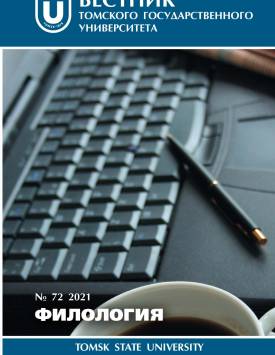Features of the Stream of Consciousness in the Absurdist Plays by Samuel Beckett
The article considers the specificity of a linguistic reproduction of the stream of consciousness in the dramatic text of Samuel Beckett’s absurdist plays. The material of the research is the text of three plays by Beckett: Waiting for Godot (1956), Krapp’s Last Tape (1958) and Not I (1972). The latter two are monodramas and are bright illustrations of the stream of consciousness technique. To compare the creative ways of employing the stream of consciousness procedure, the research involves the analysis of some episodes of Ulysses by James Joyce. The method of the research is a comprehensive linguistic and stylistic analysis of the text, complemented by some data of literary and cultural studies. Beckett and Joyce’s literary connections are taken into account as well as the philosophy and themes of the theatre of the absurd and the principles of postmodernism, particularly that of the rhizome, which inspired the use of certain linguistic means to explicate the stream of consciousness technique. Recognizing Joyce’s influence on Beckett’s works, as well as Joyce’s role in the development of the stream of consciousness technique, the research starts with the analysis of the linguistic features of this technique, employed in Ulysses. Ellipsis, aposiopesis, repetition and enumeration have been identified as the main stylistic means of the stream of consciousness. There have been identified several specific features of Beckett’s dramaturgy which distinguish it from modernists’ works and those of Joyce. Those features allow us to define Beckett as a postmodern playwright. They include linguistic negativism or “literature of the unword” (the term was offered by Beckett), the postmodernism game and rhizome, comprising fragmentarity and chaos. In addition to the cultural paradigm, another significant factor determining linguistic features of a dramatic work is its subject matter. From the variety of themes raised by the author, the most relevant to the stream of consciousness are the problems of communication, memory, traumatized consciousness and negativism. The main stage of the research is the linguistic and stylistic analyses of the texts of Beckett’s plays which have revealed the already noted stylistic means of the stream of consciousness in Ulysses by Joyce, as well as some devices peculiar to the dramatic text as a whole and Beckettian elements characteristic of his unique style. Thus, the staginess and the colloquial language of the dramatic text require additional impulses from the stream of consciousness in the form of non-literary vocabulary, rhetorical questions, and elements of intertextuality, interdiscursivity, and some extralinguistic features. The Beckettian stream of consciousness technique includes the excessive use of repetition and pauses, as well as an elaboration of a technique reproducing traumatized consciousness through linguistic and stylistic imitation of speech pathologies.
Keywords
Samuel Beckett, James Joyce, theatre of absurd, dramatic text, stream of consciousness, verbalizationAuthors
| Name | Organization | |
| Nikolaeva Marina N. | Moscow City University | marinik2@yandex.ru |
| Tomskaya Natalia N. | Moscow City University | natalie_tomskaya@mail.ru |
References

Features of the Stream of Consciousness in the Absurdist Plays by Samuel Beckett | Vestnik Tomskogo gosudarstvennogo universiteta. Filologiya – Tomsk State University Journal of Philology. 2021. № 72. DOI: 10.17223/19986645/72/14
